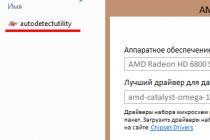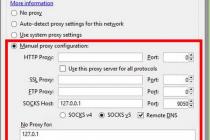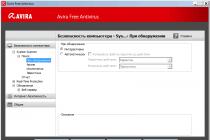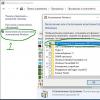Last time, we began to consider a very interesting question for people interested in computer technology - how to choose the right laptop. Indeed, choosing a good laptop can be a much more difficult task than choosing a desktop PC, as you have to consider not only performance capabilities, but also characteristics such as overall weight, comfort, size, monitor, and design.
However, hardware capabilities are no less important, because, as a rule, a laptop is purchased "once" - unlike a desktop, it is not always possible to "upgrade" a laptop. So, for what specifications should pay attention first?
CPU
Perhaps, it is the processor that is exactly the component that you need to look at first. Depending on which processor you prefer, the operation of the laptop as a whole will depend. Which processor to choose? Of course from a well-known manufacturer! At the moment, that is Intel. The main advantage of Intel lies in the use of a special SpeedStep technology to reduce power consumption and heat dissipation during operation.
Intel Core i7-980X. Processor manufactured by Intel Corporation:
AMD brand processors are less common, cheaper, but no less functional. As for the number of cores, here you need to approach individually. If you are buying a laptop for office work, a dual-core processor is enough, but for a gaming laptop, the number of cores should not be less than four. For a clock frequency of 1.6-2.0 GHz is the norm. In general, the more the better.
RAM
As you know, there is never a lot of RAM. Even for an average state employee, the amount of RAM should be at least 2 GB. Otherwise about Windows 7 as well latest versions you might not even think about it. However, you need to try very hard to find a laptop with less built-in RAM, except that it will be a simple netbook with a monitor diagonal of 10.1 inches. As for multimedia, and even more so gaming models, they should have at least 4-8 GB of RAM.
RAM module for Asus X51L X51R Z92M Z92T laptop:

Hard drives
Here everything seems to be clear without words. The larger the capacity of the hard drive, the better, although, believe me, this is not so important for a laptop. Store files big size more convenient and safer hard drives desktop computer. The norm of HDD volume for a modern laptop is considered to be 320-500 GB, but you can meet laptops with two hard drives with a total volume of more than 1 TB, for example ASUS K73Sv or Acer Ethos 5950G. The best indicator of disk rotation speed is 7200 rpm, but the standard 5400 rpm will do just fine.
Spinpoint M8. Hard disk manufactured by Samsung with a total capacity of 1 TB:

Monitor
For most modern laptops, a screen with a diagonal of 16-17 inches is the norm. For travel, it is best to take a laptop with a relatively small screen. First, a laptop with an 18-inch monitor will take up a lot of space. Secondly, this is additional weight, and carrying a car weighing 4-4.5 kilograms is still a pleasure. The next thing to pay attention to is the resolution of the monitor. If your work is related to graphics processing or you are an amateur computer games, then we advise you to choose laptops with a resolution of approximately 1600 * 900 or even 1920 * 1080 pixels.
Laptop monitor matrix:

For most budget models, the resolution is approximately 1366x768. Also pay attention to the viewing angle - and the color reproduction should not be distorted. Which type of monitor to choose: glossy or matte - you decide. Both of them have their advantages and disadvantages. A glossy surface tends to reflect objects, but the colors on it look brighter and fresher. Matte screens are reliably protected from glare, but may be inferior (very slightly) in terms of color reproduction.
video card
An important enough indicator if you are going to buy a gaming laptop. The deserved leader in the production of this important component is the American company NVIDIA. The amount of built-in memory is normal gaming video card usually 2 GB.
Video card GeForce 7900GTX Go:

Communications and battery
In general, the more ports a laptop has, the more versatile it is. A full-fledged laptop must have at least three USB port(2.0, and preferably 3.0), a microphone input, a headphone output and a card reader that supports at least four formats, ExpressCard. Availability WiFi module necessarily. Also, quite often in modern laptops you can find a built-in Bluetooth or WiMAX adapter. For multimedia notebooks, VGA connectors are mandatory (for connecting additional monitor) and HDMI (for connecting TVs).
Battery for laptop Acer Aspire 7520 series (type Li-ion, 4400mAh, 14.8V, Black):

Battery capacity is of particular importance only if you plan to work on the road or in the "field" conditions. Whatever it was, choose a laptop with battery type Li-Ion, capable of providing power for 6-8 hours. If the laptop is intended mainly for home work, then you should not chase after the battery power, it is much easier and cheaper to purchase an additional battery.
Case, keyboard, accessories and more
All these are trifles compared to the internal "stuffing", but nevertheless, in certain cases they can play important role. For example, for gaming laptops, a keyboard close to full-size is important, as well as the presence of additional gaming keys. But the most important thing is to make it as convenient as possible for you. Therefore, it would be very nice to "feel" such a laptop with your hands. Some laptops, even with very good functionality, have narrowed keys; working with such a keyboard can also cause a lot of inconvenience.
Full size laptop keyboard ASUS N73Jn:

Next to TouchPad - touch panel, there must be at least two buttons that act as mouse buttons. Some models are equipped with TrackPoint, another mouse alternative. The TrackPoint is a small joystick located most often in the center of the keyboard. As for the case, ideally it should be made of light aluminum alloy or carbon fiber, but given the relative high cost of such models, it is quite possible to get by with plastic protection. A set of accessories (a bag, a mouse, etc.) is certainly nice, but not the main thing and you shouldn't go for it. The presence of two or three accessories can be a simple marketing trick, this is how some stores "push" stale models.
Well, with technical parameters we more or less figured out, it's time to go shopping. But let's not rush, especially since we have overlooked another important detail: the brand. We will discuss this topic in more detail in the final part of our educational program.
What type of processor?
The name of the processor installed in the laptop.
The processor is one of the main components computer system. At the moment, the main manufacturers of processors for laptops are Intel and AMD.
Processors manufactured by Intel:
Pentium 4- used in laptops that serve as a replacement for a desktop PC. It features high performance, as well as high power consumption and heat dissipation and a relatively low price. Laptops on this processor can be chosen when time is not important to you battery life from batteries.
Celeron - budget version processor Pentium 4. It has a high power consumption, but at the same time the lowest price.
Pentium 4-M - mobile version Pentium 4 processor. Depending on the processing load on the processor, it can reduce the operating frequency and thus reduce power consumption.
Pentium M- a processor specially designed for mobile systems. With not the highest clock speeds, this processor successfully competes with processors for desktop systems. It has low power consumption and heat dissipation, which allows you to reduce the size of the laptop and increase its battery life.
Celeron M- budget version of Pentium M, has lower performance and lower price.
Core Solo and core duo (Core 2duo)- the next generation of mobile processors after the Pentium M. Compared to the previous generation, it has higher performance and lower power consumption. Core Duo has two computing cores, we can say that it consists of two independent processors that can perform calculations in parallel, while increasing the overall performance of the system. Notebooks based on Core Duo can be recommended for those who need both mobility and performance.
Processors manufactured by AMD:
Athlon XP-M- a processor for mobile systems, it has energy-saving technologies that can change it clock frequency depending on the load on the processor. The name of the processor indicates a number with a plus sign (for example, 2400+), which corresponds to its performance. Athlon XP-M 2400+ processor performance comparable to Pentium 4 2400 MHz
Duron Mobile- a budget option mobile processor. In terms of performance, it can be compared with the Celeron processor.
Turion 64 Mobile- mobile 64-bit processor, can work both in 32-bit mode and in 64-bit mode. When using a special (64-bit version) operating system, such a processor can operate not with 32 bits of data, but with 64 bits of data in one cycle, which can significantly increase system performance. Among other things, the processor has high performance and low power consumption, suitable for thin and light laptops. The Turion 64 Mobile can be seen as a competitor to the Pentium M.
Turion 64 X2 Mobile- dual-core mobile 64-bit processor. It has high performance and low power consumption, can be used in thin and light laptops.
Athlon 64-M- 64-bit processor for mobile systems. Has high performance.
Sempron Mobile- budget version of the mobile processor. It can be compared with the Celeron M processor. The main advantage of Sempron Mobile is low power consumption at a low price.
Apple in his laptops uses both processors of the family PowerPC G4
, and processors from Intel Core Solo and Core Duo. PowerPC G4 processors can be compared in performance to Pentium 4 processors.
- tutorial
As a rule, if the manufacturer does not give unique names to device models, then some pattern can be found in their marking.
Today I will tell you a few words about the naming of some devices from ASUS, in particular netbooks and laptops.
Let's talk about netbooks first. Take, for example, the model ASUS EeePC 1005HAG.
« Eee" in "hedgehogs" means " Easy to Learn, Easy to work, Easy to play". Everyone knows that one of the main advantages of netbooks is their compact size - I don’t remember such a device that would not fit even in the smallest backpack. And the size dictates the size of the display - it is she who is the basis of the name of each netbook. The first two digits mean the diagonal of the screen - here it is 10 inches (more precisely, 10.1). This means that in models 7xx, 9xx, 11xx and 12xx the screen diagonals are 7, 9, 11 and 12 inches, respectively.
The next two digits, in fact, do not mean anything - it's just the serial number of the model in the series. After three or four digits go letter designations. In this case, the letter H means internally used HDD(HDD), not SSD. A- the "motor" is the processor Intel Atom. G– the presence of a WiMAX module. Those. by the name alone, one can understand that this is a very modern model, which will be of particular interest to residents of Moscow, St. Petersburg, Ufa and some other million-plus cities. The rest of the alphabet looks like this:
A– Presence of an Intel Atom processor on board;
D– Presence of an Intel Celeron-M (Dothan) processor on board;
DN– the presence of a drive for disks (only in the 1004DN model);
E- High-capacity battery (for example, in 1000HE as much as 8700 mAh);
H- Availability hard drive instead of an SSD drive;
G– Presence of built-in WiMAX module;
KR– Designed by Karim Rashid (model 1008P-KR only);

P– Presence of a new Intel Atom processor (Pine Trail) on board;
S- SSD drive instead of hard drive;
T – touch screen(Touch). MT - multitouch.
X- Pre-installed Windows XP.
Letter X almost never used and used to be, for example, in the model EeePC 701SDX. However, some other characters are also very rare.
Some exceptions are the convertible netbook T91 and S101. Letter T means that the swivel touch screen is in use. In the model T91MT the screen is multi-touch. Accordingly, in T101MT just a slightly larger screen.
S101- just a stylish netbook.
There are still subscriptions 2G, 4G, 8G(in "old" models - the volume of the built-in SSD drive in GB), Surf(no webcam) and GO(the presence of a built-in UMTS module).
Eh, you also dream of matte EeePC 1101PEGST? :)
With laptops, things are somewhat more complicated. The first thing to remember about ASUS laptops is that they are all divided into 3 large segments. This - SOHO(Small Office / Home Office), business laptops and multimedia laptops. Moreover, "Business" is divided into two more categories - mobile and ultra-mobile. Those. there is no such thing that some series completely belongs to some category - in almost every line of devices there are representatives of one class or another.
SOHO. The main criteria for laptops in this segment: the most budget price, screen size 15 "-17", integrated graphics system (not discrete), mostly stationary use, designed for typical office tasks.
Ultra mobile laptops. Diagonal up to 12" inclusive, compact dimensions and low weight - up to 2 kg; mainly mobile use, for office business tasks.
Mobile laptops. Diagonal 13 "-14" inclusive, a combination of compactness, functionality and performance; versatility of use in the office and beyond.
multimedia laptops. Screen diagonal from 15"", discrete graphics card for intensive work with graphics powerful processor and large amounts of memory. Most often intended for stationary use, but there are also mobile models. The most expensive category; it also includes all gaming laptops.

The name of each model carries a lot of information, which is not difficult to “read” - it’s enough to figure out what’s what once.
Usually in the name of the model from three to five characters - consider several cases, ASUS UL30Vt, ASUS G72Gx and ASUS G51J-3D.
ASUS UL30Vt
The first letter is mandatory and indicates the series. Those. before us is the U-series. The second letter (L) is optional and is a series modifier. There are two of them - L(Thin and light) and X(Extraordinary). Accordingly, it is known that we have a thin and light laptop.
There are several series:
K (A/F/X)- budget, entry level;
R (UMPC)– the most mobile devices but not netbooks;
B, P, PL- will appear very soon and are intended for office use;
M (Multimedia)– multimedia laptops;
U / UL (UX removed)– thin, stylish and productive laptops;
N (new generation)- sufficiently powerful devices for a wide range of tasks;
G (gaming)- gaming laptops, they are also the RoG series (Republic of Gamers);
VX (Lamborghini)– a series of image devices;
W (Wide)- the rarest and most expensive, with a huge screen and two video cards.
NX (New generation, eXtraordinary)- the most-most of the "affordable".

More clearly, all series can be divided into categories, you get this picture (some models are not on it): 
Clickable

Next comes the number - it indicates the diagonal of the device. In this case it is 13 inches. So laptops UL20, UL30, UL50 are already lining up in a harmonious row. And where, you ask, is the 14-inch screen? In theory, it should be UL40 ... but in reality it is called UL80 - due to the fact that the hieroglyph for the number 4 is a homonym for the word "death", Eastern craftsmen prefer not to use it. This is the exception.
The zero in the name (second digit) is mandatory - this is the serial number of the device in the series. Accordingly, of two laptops, for example, K50 and K52 (which I recently wrote about), the second one will be newer.
The numbers are followed by two optional letters, the first of which usually indicates the platform, and the second is also a modifier. More details in the picture:

Here, perhaps, the meaning of the letter " J” - now it means that the laptop uses new processors of the Core family (i3 / i5 / i7) inside the laptop. M60J, K52J, G51J - new "peels" everywhere.
Visually, the text above can be understood from the following diagram:

Some exceptions to the rule are the budget K-series, the naming of models of which is quite difficult to remember:

ASUS G72Gx and ASUS G51J-3D
It is immediately clear that these are two gaming laptops, and the first is the second in the series and has a screen diagonal of 17 inches.However, the newer one is G51J-3D- despite the fact that this is the first gaming laptop with a 15-inch screen, it uses a new processor from the Core family, as evidenced by the letter J. Well, one more thing - the postscript "3D", which indicates that the device is capable of displaying 3D image. Accordingly, the “small” screen is there because it would be somewhat more difficult (well, more expensive) to provide a 120Hz scan on a large diagonal.
The following picture will help clarify the G-series:

You can practice: K40IJ, K52, UL20A, UL50Vt, UL80, M60J, N61, G60J, VX5.
It is even somehow strange that not a single laptop received a separate sonorous name (the VX Lamborghini series does not count). By the way, the VX-series is simply numbered in order - VX1, VX2 ...
The Internet penetrates into the most remote corners of the world. The volume of information is growing along with the rhythm of life, and modern man I learned to work and rest "on the go." This is largely facilitated by the development portable devices without which everyday life is hard to imagine.
Laptops are such useful gadgets. They have become so compact that they can be taken with you anywhere, and the level of performance offered allows you to solve any tasks. Every day this variety personal computers is becoming more and more in demand, and the range includes more than one hundred models.
In such an abundance, you can get confused, especially when it comes to choosing a laptop from one of the largest vendors - ASUSTeK (Asus). Of course, the manufacturer facilitates this task by positioning its laptops (digital home, business, style, portable, personal entertainment center and super mobile), but in order to figure out which laptop is best suited for what tasks, this may not be enough. It would not be bad to know what ideas were put into this or that laptop at the development stage and for what purposes it was released from the assembly line.
This will be discussed in this article. As a basis, we will take the concepts of building a lineup of Asus laptops. This will help you get an idea about the principles of forming a series of laptops from this manufacturer, as well as quickly navigate when choosing a future laptop. In addition, we will talk about the language in which the names of Asus laptops are compiled, but first we briefly recall the main properties of mobile computers.
The main parameters of laptops
Any laptop has five key parameters that determine its purpose and place in the lineup. Knowing them, you can easily find an approach to evaluate any laptop.
performance or power- one of the most important parameters. It is understood as the computing potential of the filling of a laptop: a processor, RAM, video card and main system media (HDD, SSD). The more powerful the laptop, the more tasks in a shorter period of time it can perform. Working on a productive laptop is much more comfortable, but its cost directly depends on this indicator.
On the other hand, in a different range of tasks (work, games, mail and Internet surfing, working with multimedia content) different capacities are required. So that the buyer does not overpay for unclaimed laptop resources, manufacturers create models with different levels of performance. Thanks to this, it is possible to choose the most suitable laptop both in terms of features and price.
Dimensions and weight. The more often a laptop is carried with you, the more you want it to be light and compact. The whole day to carry with you "Tom Big Soviet encyclopedia“Not everyone is ready. Manufacturers are trying to reduce the size and weight of laptops, but put in thin cases powerful hardware and at the same time providing the necessary cooling is expensive ... The more compact, lighter and more productive the laptop, the higher its cost. But finding a compromise between screen sizes, the required level of mobility and performance, and the size of the budget is a very real task. The main thing - without fanaticism.
And vice versa - for those who prefer a home laptop to a stationary computer, the dimensions and weight are not so critical. Therefore, it does not make sense for them to pay more for this parameter.
Endurance determines the battery life of the laptop, that is, the time that it can work without recharging. It depends both on the properties of the batteries themselves, and on the appetite of the electronics. The more voracious the iron, the faster it will empty the “tank”. Therefore, ultra- and superportable laptops, unlike their more sedentary counterparts, are assembled on the basis of low-power platforms.
But do not forget that the battery life is more dependent on the computing load of the system. Even if an ultra-efficient car is loaded to the limit, drown the gas pedal to the floor and drive uphill for a long time, gas will run out quickly. So maximum time laptop battery life, specified in the configuration, is measured in gentle operating modes.
Possibilities of connection of peripheral devices and access to the Internet. This parameter determines the communication potential of the notebook. The necessary ports (slots) will help you conveniently organize data transfer or connect desired devices, and built-in network cards will allow you to always stay in touch.
At the same time, not everyone needs the whole arsenal, and the size of a laptop does not always allow even a third USB port to be placed. Therefore, depending on the purpose of the laptop, additional ports or communication facilities may be added to the basic set of capabilities.
Zest. Some laptops have a bright detail that is unique to them and makes them stand out. This is a unique feature. These include: design, all kinds of colors, finishes, data protection systems and much more ...
For example, for corporate laptops, the case design and its external design do not play any role, and if a laptop, in addition to an everyday assistant, is also an accessory, then it would be useful to give it some personality with a beautiful finish.
As you already understood, by varying the main parameters, you can create a wide range of laptops for a variety of tasks and needs, and combine laptops with similar properties into series. Now let's look at the principles by which Asus does this.
Hierarchy of Asus laptops
First, all laptops are divided into segments by purpose and by the main areas of their use. Further, according to a number of features, they belong to certain groups and series, that is, the main directions become narrower and more specific.
A series is a series of models united on some basis. Series are made up of models. That's all. As you can see, the circuit is very simple.
Pay attention to the diagram. It shows how the main parameters of laptops correlate depending on the segments. Next, we will analyze each segment in more detail and give illustrative examples of their representatives.
SOHO
Segment SOHO, which stands for Small Office Home Office. SOHO-books are unpretentious hard workers, created for work in small organizations and home offices. Their typical tasks are simple: text, documents, internet, photos, movies. They do not require powerful hardware, so they are equipped with medium processors and integrated graphics. They work mainly in a hospital, which means a long offline time, dimensions, weight and the broadest communication capabilities are also not critical. But big screen(15-17 inches) and comfortable ergonomics will come in handy. Well, since most of the parameters are far from top-end, then the price is low.
For example, we recommend Asus K50IN- model with very good hardware (dual-core Celeron 1800 MHz, DDR2 RAM 2 GB, HDD 250 GB, external graphics nVidia GeForce G 102M, 15.6" screen) at a reasonable price. If you're looking for a simple yet powerful laptop, take a look at this one, it's a worthy candidate.
If the cost is in the first place, you should take a look at one of the most inexpensive models in the segment - Asus X58C. For her money, she has good components, which are more than enough for office work. And the 15-inch screen is an excellent compromise between convenience (in most cases, it will be enough for comfortable work) and mobility.
NETBOOKS
Netbooks are small, lightweight laptops designed to work on the Internet. On the official website of Asus, they are assigned to the EEE PC family, but we will still talk about them as a class of laptops.
Not all laptops are suitable for constantly carrying them with you. Even 2 kg of hand luggage with daily wear delivers a significant inconvenience. Smartphones are cheaper and lighter, but they have small screen and tiny buttons. A reasonable balance could be MID or communicators - they are small, light (compared to laptops), hardy (the charge is enough for at least a day), and functional. But the screens are still small. So what is the ideal device for the Internet?
The solution to the problem was literally in the air, and Asus was the first to feel it. In 2007, as an experiment, she brought to the market the first netbook - Asus Eee PC 701. It was not perfect, but it laid a new branch in the development of mobile laptops. The popularity of netbooks is growing every day, which has led to the formation of a separate viable segment.
Netbooks are characterized by high mobility, small dimensions, weight no more than 1.5 kg, screen size up to 12 inches, wide communication capabilities, good endurance (up to 8 hours of battery life) and affordable price. The existing pluses are diluted by the average performance, which, however, is quite enough to solve the tasks facing them.
Take a look at one of the most affordable models in the series - 10.1-inch Asus Eee PC 1005HA. It is more than enough for Internet surfing, watching movies, office applications and checking mail. It offers 160 GB of disk space, as well as an Atom N270 processor with a frequency of 1.6 GHz and 1 GB of RAM.
If a 10-inch display is not enough for you, take a closer look at models with 11-inch ones - for example, to Asus Eee PC 1101HA not inferior to the previous model.
For people who appreciate style as well as features, we recommend the Eee PC Seashell series. The Seashells have all the benefits of the regular Eee-series, plus they're stylish, slim and eye-catching.
BUSINESS
Over the years, a number of requirements have been formed for business laptops. Business people work a lot - including on the go. This means that business laptops, above all, must be compact (not the smallest, but compact), at the same time have the necessary performance and long battery life.
Businessmen want to stay connected, so laptops in this class are equipped with wide communication capabilities. Well appearance not in last place: since in the corporate world a lot depends on presentability, business laptops are always “dressed to the nines”.
As you can see, almost all parameters are at the highest level.
The business segment is divided into two groups: mobile and ultra-mobile models. The main difference between these groups of laptops - the size and weight. Ultra-mobile laptops are more likely to be used on the go, so they're lighter and more compact. Mobile phones are aimed at those people who work both on the road and “in the hospital”. Accordingly, they have larger screen sizes and dimensions.
A significant role in the development of this segment was played by the Thin & Light concept, the idea of which is to reduce dimensions and weight without sacrificing performance and endurance. Read more about the concept in this article.
Representative of the ultramobile group - Asus F9E. The 12-inch laptop features decent hardware (a dual-core Intel DualCore T2330 processor, a gigabyte of RAM, a 160 GB hard drive), as well as a fingerprint scanner. As an option, there is a 3G / 3.5G + SIM-slot module. Another plus of this model is an attractive price.
Standing out from the mobile laptop camp is a balanced Asus F80Cr with an average processor, but 2 GB of RAM, hard drive for 250 GB and discrete graphics ATI Radeon HD 3470. The laptop keyboard is protected from liquids - it is not afraid of water, coffee or other liquids.
MULTIMEDIA
Do you work in graphics, video or other media applications? Do you play the latest games? Do you love movies? If the answers are positive, then the multimedia segment is created for you. These laptops have good performance. They have the most modern processors, powerful external graphics cards, capacious hard drives and ample opportunities for connecting peripherals. All advanced developments most often appear in this segment.
Since "multimedia" are used mainly stationary, dimensions, weight and battery life are not critical for them. But good screen, a comfortable keyboard and high-quality sound should be their integral components. Therefore, the screens are from 15 inches, the keyboards are full-sized, and the speaker power is enough to watch a movie in a large company.
The difference in cost is quite significant. In the segment there are models both at very affordable and at more tangible prices. Here, as with cars, it all depends on the “stuffing” of the model.
A bright representative of the segment at an affordable price - Asus K50Ab. Just take a look: dual core AMD processor Athlon Neo X2 Dual-Core 2100MHz Puma (QL-64), 2GB RAM, 250GB HDD, ATI Mobility Radeon HD 4570 discrete graphics (512+639MB) and of course 15.6" LED screen (1366x768). This laptop is suitable for both productive work and multimedia. Toy lovers will not be offended either.
Let's summarize the described concepts with a visual diagram.

Horizontal axis - division by portability; on the left - mobile solutions, on the right - desktop. Vertically - division by combination of power and battery life (the more powerful the iron, the more energy it consumes, the faster it will “eat up” the battery). According to these "coordinates" the described segments are distributed.
Now let's move on to the "language" in which the names of Asus laptop models are compiled.
Asus language
The Taiwanese vendor names all models according to a certain scheme. Knowing it, you can understand some of the properties of a laptop simply by its name, without even seeing it.
"name" any Asus models consists of letters and numbers arranged in a certain order. Let's take the M51Sr as an example.
The first letter ("M") stands for series. As you already know, Asus distinguishes several series: gaming, ultra-mobile, exclusive Lamborghini and so on. The first letter is the most important: it tells us almost everything about the laptop. In our example, a multimedia series is encrypted.
Then the first digit ("5") follows - this is the diagonal of the screen. In Asus parlance, five means 15-inch display.
You can ignore the second digit (“1”). It reflects the sequence of model development; it doesn't matter to the buyer.
But let's take a closer look at the second letter ("S"), since it encodes the base of the laptop - the platform. Asus divides platforms by manufacturer (Intel, AMD, ATI) and graphics type (integrated or external, i.e. discrete). We have Intel platform Santa Rosa with exterior graphics.
The third letter ("r"), unlike the others, is lowercase. She tells us about the graphics system. In our example - entry-level ATI.
The spell has been deciphered: we have a 15-inch Santa-Rosa-based multimedia notebook with ATI external budget graphics.
As you can see, basic information about any car can already be gleaned from the name.
This table lists almost all the characters found in the names of Asus devices. Please note that the list of series in the table is incomplete. And although these data are taken from official sources and represent general scheme, sometimes there are exceptions.
| First letter | First digit | Second letter | Third letter | ||||
| series | screen diagonal, inches | platform | graphics system | ||||
| A | initial | 1 | 11 | H/L | budgetary | e/r | initial ATi graphics |
| B | business/tablet pc | 2 | 12 | F/J | intel, Napa (integrated/external graphics) | a/p | top ATi graphics |
| G | game | 3 | 13 | E/S | intel, Santa-Rosa (integrated/external graphics) | c/g | initial nvidia graphics |
| K | the most accessible | 5,6 | 15 | A/V | intel, Montivina (integrated/external graphics) | v/s/n/m | top nvidia graphics |
| M | multimedia | 7 | 17 | R | series based on ATi chipset | ||
| R | UMPC | 8 | 14 | U/N/M/Z | AMD (int. graphics) | ||
| U | ultramobile | 9 | 20 | D/K/T | AMD (external graphics) | ||
Conclusion
As you can see, ASUS offers a huge range of laptops with different features and specifications. Among them, everyone can find a suitable laptop. But do right choice is not always easy, especially when dealing with so many notations, characteristics and short descriptions.
This article shows the general concepts of building the Asus laptop lineup, which can help you navigate the abundance of models and make the right choice.
We also note that the considered classification is also valid for laptops from other major manufacturers. Of course, there are differences, but the main ideas for the formation of the model range remain relevant.
About company
Company ASUS TeK Computer Inc.
. was established in 1989 in Taiwan. The name of the company and the ASUS brand are derived from the word Pegasus, which in Greek mythology means "rebirth" and "success". The current position of the corporation in the world market is consistent with this name.
Currently, ASUS Corporation is one of the five largest manufacturers of computer equipment in the world, and in recent years it has been ranked second and third in terms of deliveries to Russia. The company has branches in Taiwan, China, USA and Germany.
The company started with chipsets and motherboards. Next, optical drives and video cards were added. By order of HP, ASUS Corporation began to supply servers. In 2000, the first ASUS laptop was introduced, in 2001, a server under its own name was released. In 2007, ASUS was the first to bring a netbook to the market - this is the Asus Eee PC 701 netbook.
ASUS has constantly expanded its field of activity and today it supplies to the world market: desktop PCs, monitors, Eee - (netbooks), communicators and GPS, network equipment, laptops, accessories, servers and workstations, PC components. It is interesting to note that in the above list, and it is taken from the data provided by ASUS itself, netbooks are singled out in a separate position and are called Eee devices.
ASUS laptops: classification and designations
ASUS Corporation is very quick to respond to any changes, both in the consumer market and in technical or design terms. And the most natural reaction for the manufacturer is the release of a new series of laptops. A new niche has emerged in the consumer market - New episode laptops, a new platform or new technology- another series of laptops.
ASUS laptops are divided into series that contain models. Some series may have only one model. Series are usually denoted by one capital Latin letter and one, rarely two, numbers. For example - A1, F3, G50, etc. The exceptions are a series of netbooks, which have the designation ASUS Eee, and a series of stylish laptops ASUS LAMBORGHINI and ASUS Bamboo.
To date, almost all letters of the Latin alphabet have already been used and series with two letters at the beginning have begun to appear. For example - UL20, UX30.
Given the large number of series, the description of each of them will take up a lot of space. Therefore, we will provide information on which segments ASUS currently divides the laptop market into and which modern series it refers to each of the segments:
- universal laptops: F3, F5, F6, F7, F8, F50, K40, K50 series
- portable laptops: UL30, F9, N10, R1, R2, S6, U2, U3
- gaming laptops: G1, G2, G50, G51, G70, G71
- multimedia laptops: F70, M50, M51, M70
- stylish laptops: VX1, VX2, VX3, Bamboo.
ASUS Exclusive Innovations
The success achieved by ASUS Corporation would not have been possible without the use of original technologies and innovations. To a large extent, it is the active research work and the rapid implementation of new technological solutions that have allowed ASUS to take a leading position in the global notebook market.
Super Hybrid Engine (SHE) - extended battery life. Technology benefit (SHE) can be as high as 15%.
Hybrid Storage - additional features for data storage. Using built-in solid-state SSD and SD flash cards provide more flexible, convenient and secure data storage.
XpressPath - acceleration of loading and shutdown. This effect is realized when using faster SSD memory.
Multi Touch - multitouch touchpad. This is the ability to control a laptop equipped with a touch screen by simultaneously touching the monitor with two fingers.
active management, high quality, reasonable pricing policy, extensive research work and wide introduction of innovations allow us to recommend Asus laptops for all categories of users.













